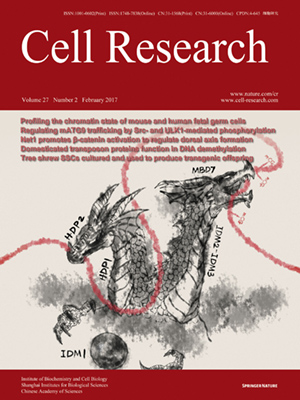Volume 27 Issue 2, February 2017: 165-183 | Open Access
ORIGINAL ARTICLES
DNA methylation and chromatin accessibility profiling of mouse and human fetal germ cells
Hongshan Guo1,*, Boqiang Hu1,*, Liying Yan1,2,3,*, Jun Yong1,2,3,*, Yan Wu4, Yun Gao1, Fan Guo1, Yu Hou1, Xiaoying Fan1, Ji Dong1, Xiaoye Wang1,2,3, Xiaohui Zhu1,2,3, Jie Yan1,2,3, Yuan Wei1,2,3, Hongyan Jin1,2,3, Wenxin Zhang1,2,3, Lu Wen1,5, Fuchou Tang1,5,6,7 and Jie Qiao1,2,3,7
1Department of Obstetrics and Gynecology Third Hospital, Biomedical Institute for Pioneering Investigation via Convergence & Center for Reproductive Medicine, College of Life Sciences, Peking University, Beijing 100871, China
2Key Laboratory of Assisted Reproduction, Ministry of Education, Beijing 100191, China
3Beijing Key Laboratory of Reproductive Endocrinology and Assisted Reproductive Technology, Beijing 100191, China
4National Institute of Biological Sciences, Beijing 102206, China
5Ministry of Education Key Laboratory of Cell Proliferation and Differentiation, Beijing 100871, China
6Beijing Advanced Innovation Center for Genomics, Beijing 100871, China
7Peking-Tsinghua Center for Life Sciences, Peking University, Beijing 100871, China
Correspondence: Fuchou Tang, E-mail: tangfuchou@pku.edu.cn; Jie Qiao,(jie.qiao@263.net)
Chromatin remodeling is important for the epigenetic reprogramming of human primordial germ cells. However, the comprehensive chromatin state has not yet been analyzed for human fetal germ cells (FGCs). Here we use nucleosome occupancy and methylation sequencing method to analyze both the genome-wide chromatin accessibility and DNA methylome at a series of crucial time points during fetal germ cell development in both human and mouse. We find 116 887 and 137 557 nucleosome-depleted regions (NDRs) in human and mouse FGCs, covering a large set of germline-specific and highly dynamic regulatory genomic elements, such as enhancers. Moreover, we find that the distal NDRs are enriched specifically for binding motifs of the pluripotency and germ cell master regulators such as NANOG, SOX17, AP2γ and OCT4 in human FGCs, indicating the existence of a delicate regulatory balance between pluripotency-related genes and germ cell-specific genes in human FGCs, and the functional significance of these genes for germ cell development in vivo. Our work offers a comprehensive and high-resolution roadmap for dissecting chromatin state transition dynamics during the epigenomic reprogramming of human and mouse FGCs.
10.1038/cr.2016.128
FULL TEXT | PDF
Browse 2283


